Ulster AGS Show, 2011
Exhibitors belonging to both the Ulster and the Dublin AGS Local Groups have over the years grown many very good plants whose flowerings peak around the time. But in 2011, the International Conference and other events meant that the Ulster Show was delayed until early May. This revised date, combined with exceptionally warm April weather, really put them on their mettle. Despite a slight dip in the number of plants staged, they certainly rose to the challenge with a varied range of first-rate plants, in the Open Section most notably. Entries in the Intermediate and Novice Sections were reduced in comparison with previous years, but here too the entries were overall of a high standard.
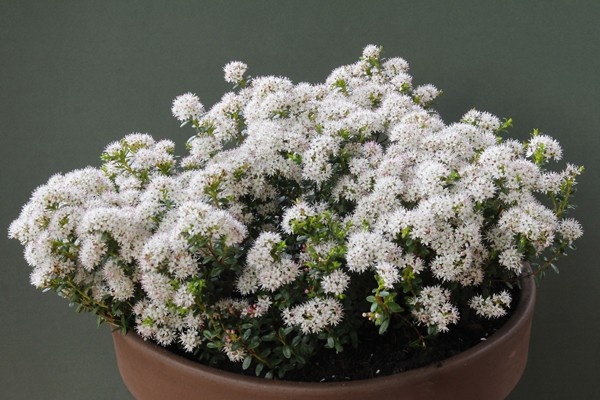 Leiophyllum buxifolium, an excellent, floriferous specimen grown by George & Pat Gordon that had been recently dug up from a high humus bed, scooped the Farrer Medal. This species has a reasonably compact rootball, in its dwarfest forms most especially, and if kept well-watered doesn’t resent such treatment. Grown in light shade, it receives sufficient sunshine to flower generously, and further benefits from occasional liquid feeds formulated for ericaceous plants, and an annual mulch. Last winter it was buried under a 60cm deep insulating blanket of snow for some five weeks, and as such suffered no ill effects from the cold snap. Fittingly, in that the exhibitors were close friends with the late benefactor, it also received the Carol McCutcheon Award for the best pan of Ericaceae other than Rhododendron.
Leiophyllum buxifolium, an excellent, floriferous specimen grown by George & Pat Gordon that had been recently dug up from a high humus bed, scooped the Farrer Medal. This species has a reasonably compact rootball, in its dwarfest forms most especially, and if kept well-watered doesn’t resent such treatment. Grown in light shade, it receives sufficient sunshine to flower generously, and further benefits from occasional liquid feeds formulated for ericaceous plants, and an annual mulch. Last winter it was buried under a 60cm deep insulating blanket of snow for some five weeks, and as such suffered no ill effects from the cold snap. Fittingly, in that the exhibitors were close friends with the late benefactor, it also received the Carol McCutcheon Award for the best pan of Ericaceae other than Rhododendron.
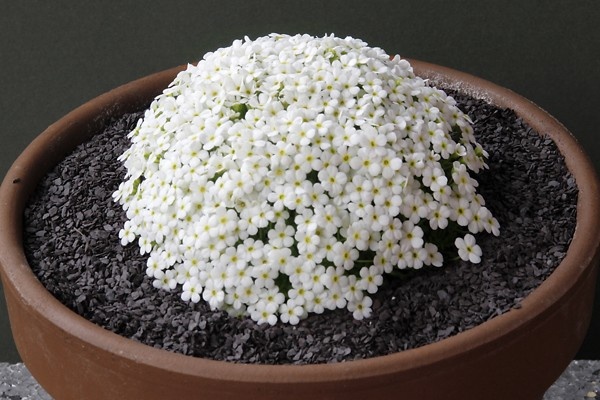 Ian Leslie (Bangor) caught the ferry over from the mainland, his Androsace cylindrica winning the SRGC Quaich for the best plant in a 19cm pot. Grown from Androsace Group seed sown in December 2005, it had responded well to an open, very gritty (60%) rooting medium, producing a solid dome of pure white flowers.
Ian Leslie (Bangor) caught the ferry over from the mainland, his Androsace cylindrica winning the SRGC Quaich for the best plant in a 19cm pot. Grown from Androsace Group seed sown in December 2005, it had responded well to an open, very gritty (60%) rooting medium, producing a solid dome of pure white flowers.
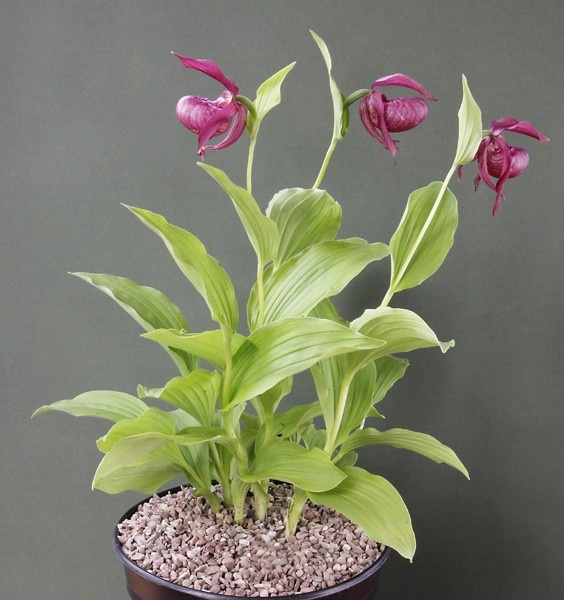
Ian also showed pans of the western Chinese, rose-purple flowered Cypripedium franchetii (grown in a mixture of composted bark, peat and Perlite in a cool, moist position outdoors during the summer, then placed under the alpine house benching throughout the winter)
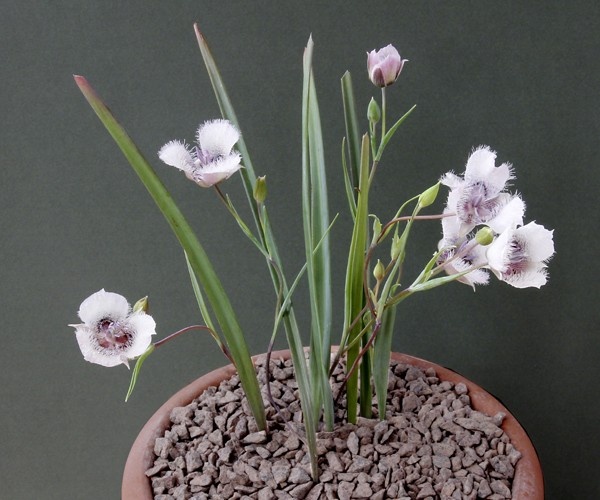
and the elfin Calochortus tolmiei from the Siskiyous, this example, from Josephine County, Oregon, representing a pale rose-pink form with a dark centre and up to six flowers per stem. Sown 10 years ago, it had been grown in a 50:50 mix of John Innes no. 2 and grit. Kept outside for much of the year, with cold frame protection in the winter months, this was its best performance to date.
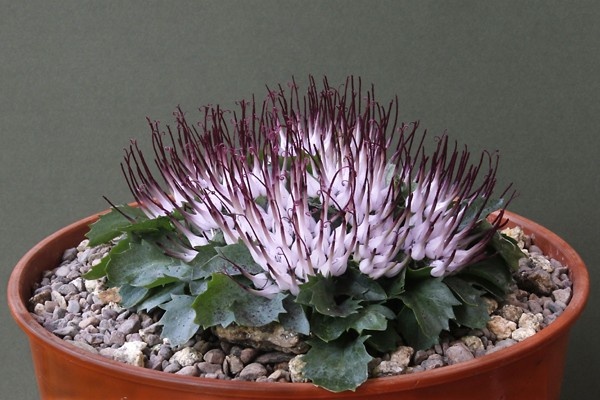 A Certificate of Merit went to a well-flowered pan of Physoplexis comosa, brought along by stalwart exhibitor Liam Byrne. Grown from seed some 10 years ago, it was at its peak a month or more before the usual peak flowering date for this species when in captivity. Following its flowering, the plant is sheltered from strong sunshine and stowed under an alpine house staging until the leaves die away. The ruby-red shoots first emerge in March, after which four liquid feeds of a tomato fertiliser are administered during the course of the growing season. A standard compost of equal parts loam, leaf-mould and grit is used for this and other plants: he received the Cooke Cup for the most first prize points in the Open Section. Surely the soft Dublin rain wasn’t entirely responsible for its rude good health!
A Certificate of Merit went to a well-flowered pan of Physoplexis comosa, brought along by stalwart exhibitor Liam Byrne. Grown from seed some 10 years ago, it was at its peak a month or more before the usual peak flowering date for this species when in captivity. Following its flowering, the plant is sheltered from strong sunshine and stowed under an alpine house staging until the leaves die away. The ruby-red shoots first emerge in March, after which four liquid feeds of a tomato fertiliser are administered during the course of the growing season. A standard compost of equal parts loam, leaf-mould and grit is used for this and other plants: he received the Cooke Cup for the most first prize points in the Open Section. Surely the soft Dublin rain wasn’t entirely responsible for its rude good health!
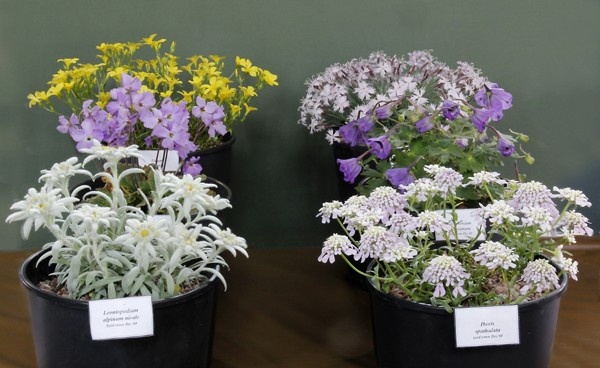 The AGS small six-pan medal was won by another long-distance exhibitor, Lionel Clarkson, with a floriferous set of plants, including Linum uninerve (a recent introduction from Bulgaria’s Rhodope Mts with yellow flowers, yielded in succession for weeks on end) and Delphinium beesianum, the seed sent back from Min Shan, Sichuan by Vojtĕch Holubec at 4000m on limestone scree (grown in a compost of three parts John Innes no. 3, five parts grit and one part composted bark).
The AGS small six-pan medal was won by another long-distance exhibitor, Lionel Clarkson, with a floriferous set of plants, including Linum uninerve (a recent introduction from Bulgaria’s Rhodope Mts with yellow flowers, yielded in succession for weeks on end) and Delphinium beesianum, the seed sent back from Min Shan, Sichuan by Vojtĕch Holubec at 4000m on limestone scree (grown in a compost of three parts John Innes no. 3, five parts grit and one part composted bark).
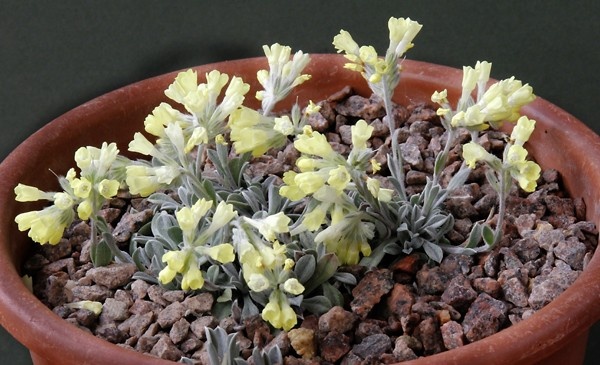 The small Open Section three-pan class for plants raised from seed always attracts my attention. The winning trio, all impeccably presented by Harold McBride, gained him the Phebe Anderson Trophy. They comprised the pillar-box red, Chinese Androsace bulleyana (which he has maintained from seed some 20 years, the initial stock provided by that fondly-remembered grower of the genus Duncan Lowe), the refined European Leontopodium alpinum subsp. nivale and the narrowly endemic New Zealander Myosotis albosericea, which also won the Alpines '96 Award (for the best Australasian plant exhibited). As with the androsace it is a short-lived species, which the exhibitor and a few other enthusiasts have kept going from the original introduction. Just as well, for its rarity in the wild makes the prospect a re-introduction unlikely. Harold afterwards described it as challenging and in need of careful watering. Grown in a 50:50 mix of John Innes no. 2 and grit, it perpetuates by setting copious amounts of seed annually.
The small Open Section three-pan class for plants raised from seed always attracts my attention. The winning trio, all impeccably presented by Harold McBride, gained him the Phebe Anderson Trophy. They comprised the pillar-box red, Chinese Androsace bulleyana (which he has maintained from seed some 20 years, the initial stock provided by that fondly-remembered grower of the genus Duncan Lowe), the refined European Leontopodium alpinum subsp. nivale and the narrowly endemic New Zealander Myosotis albosericea, which also won the Alpines '96 Award (for the best Australasian plant exhibited). As with the androsace it is a short-lived species, which the exhibitor and a few other enthusiasts have kept going from the original introduction. Just as well, for its rarity in the wild makes the prospect a re-introduction unlikely. Harold afterwards described it as challenging and in need of careful watering. Grown in a 50:50 mix of John Innes no. 2 and grit, it perpetuates by setting copious amounts of seed annually.
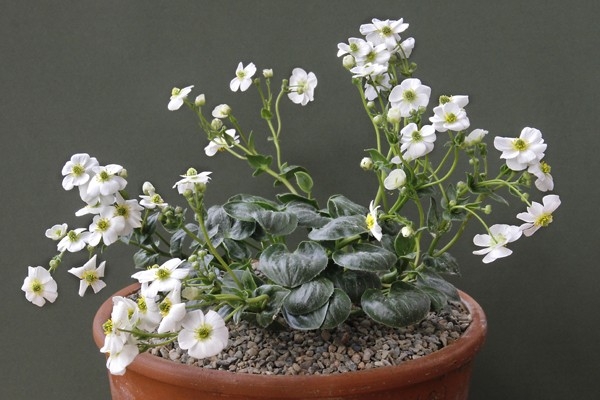 A fine specimen of Ranunculus parnassifolius, raised from seed, was shown by Bob Gordon in a large, long tom clay pot. Deep-rooted when happy, it appreciates a rich, free-draining compost, and is most usually white-flowered in its European range, though in some westernmost stations, in both parts of the Pyrenees (Val d’Eyne, Nuria especially and the Cordillera Cantabrica) the flowers can be sumptuously pink.
A fine specimen of Ranunculus parnassifolius, raised from seed, was shown by Bob Gordon in a large, long tom clay pot. Deep-rooted when happy, it appreciates a rich, free-draining compost, and is most usually white-flowered in its European range, though in some westernmost stations, in both parts of the Pyrenees (Val d’Eyne, Nuria especially and the Cordillera Cantabrica) the flowers can be sumptuously pink.
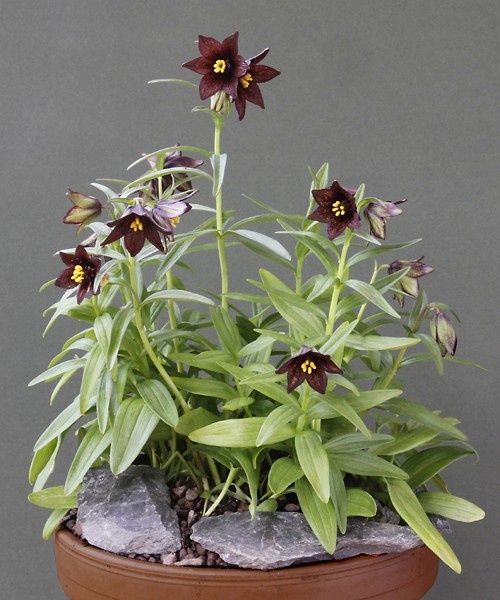
A compact, well-flowered Fritillaria camschatcensis, one of the latest flowering of the genus, was voted best plant in the Intermediate Section, and as such won the Betty Hill Trophy for Liam & Joan McCaughey. Grown in a standard ‘alpine’ mix, it had been left outside throughout the winter in a slightly sheltered site.
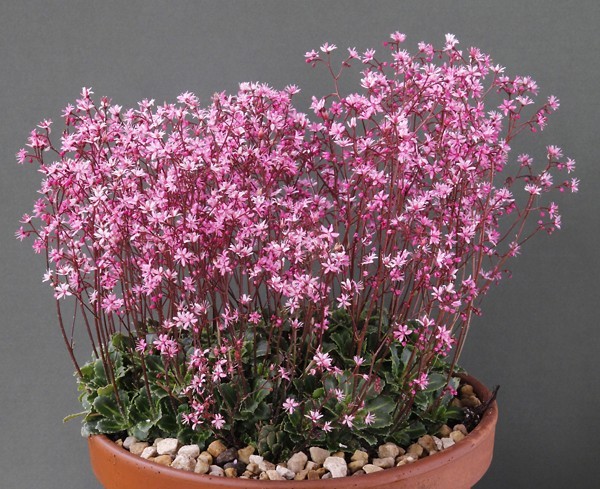 Exhibitors in search of a consistently free-flowering, late spring plant need look no further than Saxifraga primuloides ‘Clarence Elliott’, a London Pride exemplar barely 15cm tall with delicate sprays of small pink flowers that was selected by the Six Hills nurseryman of enduring repute. A very healthy, floriferous plant had been dug up from her garden by exhibitor Patricia McGeown, and was the subject of much favourable comment.
Exhibitors in search of a consistently free-flowering, late spring plant need look no further than Saxifraga primuloides ‘Clarence Elliott’, a London Pride exemplar barely 15cm tall with delicate sprays of small pink flowers that was selected by the Six Hills nurseryman of enduring repute. A very healthy, floriferous plant had been dug up from her garden by exhibitor Patricia McGeown, and was the subject of much favourable comment.
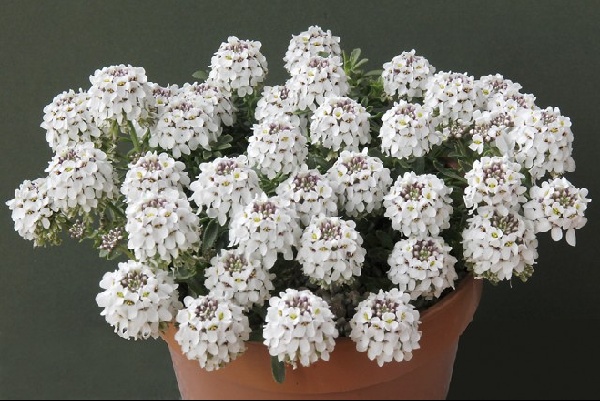 Kay & Sam McDowell also enjoyed success with their exhibits. She received the J.A.E. Hill Trophy for most points in the Intermediate Section, while he scooped the Malcolmson Cup for most first prize points in the Novice Section. Sam also took home the C.H. Hammer Trophy with an eye-catching exhibit of Iberis oschtenica, a narrowly endemic crucifer from the westernmost Caucasus that flowers for a long period, but needs to be propagated from cuttings very early in the spring, for it has a tendency to flower itself to death without setting seed unless several plants are grown together and cross-pollinated.
Kay & Sam McDowell also enjoyed success with their exhibits. She received the J.A.E. Hill Trophy for most points in the Intermediate Section, while he scooped the Malcolmson Cup for most first prize points in the Novice Section. Sam also took home the C.H. Hammer Trophy with an eye-catching exhibit of Iberis oschtenica, a narrowly endemic crucifer from the westernmost Caucasus that flowers for a long period, but needs to be propagated from cuttings very early in the spring, for it has a tendency to flower itself to death without setting seed unless several plants are grown together and cross-pollinated.
